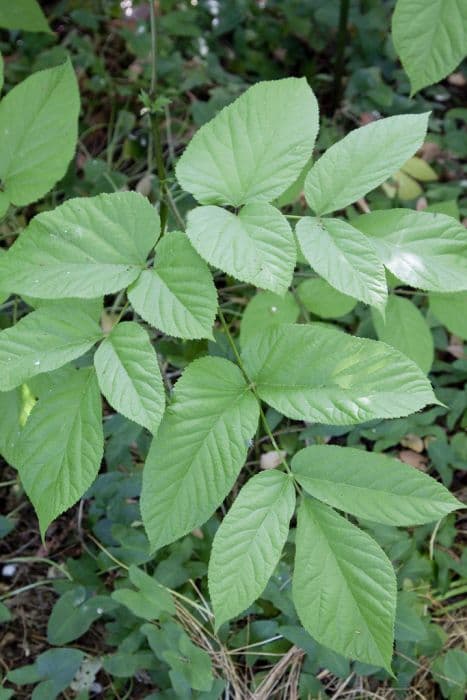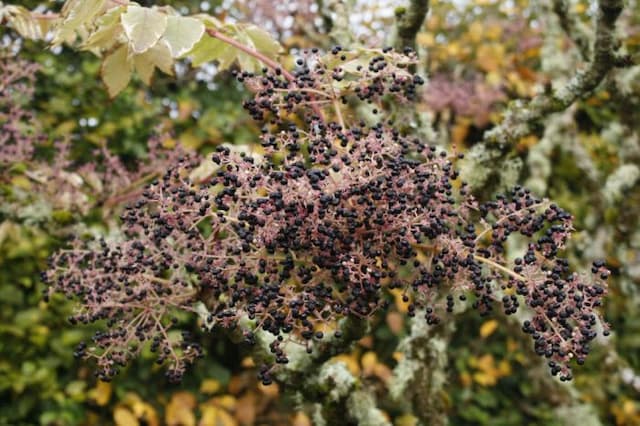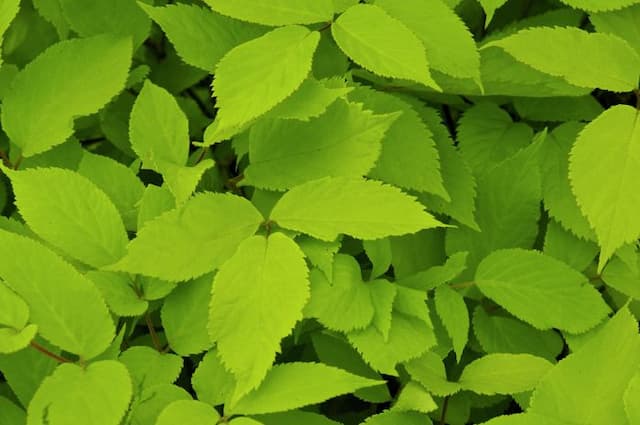Devil's Walking Stick Aralia spinosa L.






ABOUT
The plant commonly known as devil's walking stick is a visually striking plant that features a number of distinct characteristics. Its stem is covered with numerous sharp spines, which can deter animals and humans from handling it. The leaves of the devil's walking stick are quite large, compound, and finely divided. They give the plant a feathery appearance from a distance, with each leaf being made up of numerous small leaflets arranged on either side of a central stem. During the blooming period, the plant produces large, white inflorescences which consist of many small flowers packed tightly together in an umbrella-like shape. These flower clusters are not only attractive but also often visited by various insects. After flowering, the plant bears fruit in the form of small, round berries that can range in color from dark purple to black when ripe. The fruit clusters are often dense and can be quite conspicuous against the foliage. The bark of the plant is rough and it also bears the characteristic spiny protuberances that contribute to its common name. The overall texture and appearance of devil's walking stick make it a unique and memorable plant, with its formidable spines and large leaves creating a distinctive profile in the landscape.
About this plant
 Names
NamesFamily
Araliaceae.
Synonyms
Devil's Walking Stick, Hercules' Club, Angelica Tree, Prickly Ash, Prickly Elder.
Common names
Aralia spinosa var. inermis Fernald, Aralia spinosa var. echinata Fernald.
 Toxicity
ToxicityTo humans
Devil's walking stick is not commonly known for its toxicity to humans when touched or ingested. However, caution is advised as there is not an extensive amount of research regarding its potential toxic effects if consumed in large quantities, and the spines can cause physical injury if handled improperly. It is always recommended to avoid ingesting parts of plants that are not known to be safe and to consult with a healthcare provider if ingestion occurs.
To pets
Devil's walking stick is not commonly recognized as a toxic plant to pets. However, similar to humans, its spiky stems may cause physical injury to pets if they attempt to chew on it. As with any non-food plant, ingestion should be avoided, and pet owners should monitor their pets to prevent accidental consumption. If a pet does ingest part of the plant, monitoring for any signs of distress and consulting with a veterinarian is advisable.
 Characteristics
CharacteristicsLife cycle
Perennials
Foliage type
Deciduous
Color of leaves
Green
Flower color
White
Height
10-25 feet (3-7.6 meters)
Spread
6-12 feet (1.8-3.6 meters)
Plant type
Tree
Hardiness zones
4
Native area
Eastern North America
Benefits
 General Benefits
General Benefits- Ornamental value: Aralia spinosa, commonly known as devil's walking stick, is often used in landscaping for its unique appearance, with large compound leaves and spiky stems adding a dramatic accent to gardens.
- Wildlife habitat: The plant provides shelter and nesting sites for various bird species, and its dense foliage offers protection for small animals.
- Food for wildlife: Its berries are a food source for birds and other wildlife, contributing to the biodiversity of an area.
- Erosion control: With its robust root system, devil's walking stick can help stabilize soil and prevent erosion in certain environments.
- Shade provider: The large leaves of Aralia spinosa can create a canopy that offers shade, making it suitable for planting in areas that require protection from direct sunlight.
- Privacy screen: Due to its fast growth and dense foliage, it can be used as a natural privacy screen in gardens and landscapes.
- Windbreak: The plant can act as a windbreak when planted in rows or clusters, protecting more sensitive plants and reducing wind erosion.
- Seasonal interest: The plant has seasonal appeal with its summer flowers, fall berries, and autumn foliage color, contributing to year-round interest in a garden setting.
- Education and research: Aralia spinosa can be a subject of botanical study and education due to its unique morphological features.
- Cultural significance: In some cultures or regions, plants like devil's walking stick may hold traditional or aesthetic value, adding to the cultural richness of an area.
 Medical Properties
Medical Properties- Analgesic: Aralia spinosa, commonly known as devil's walking stick, has been traditionally used to alleviate pain.
- Anti-inflammatory: The plant has been used for its potential to reduce inflammation.
- Diuretic: It has been believed to help promote the production of urine, aiding in the flushing of the urinary tract.
 Air-purifying Qualities
Air-purifying QualitiesThis plant is not specifically known for air purifying qualities.
 Other Uses
Other Uses- As a food source: Although not commonly consumed, the young shoots of the devil's walking stick can be cooked and eaten like asparagus.
- In landscaping: The tree's unique appearance with its large compound leaves and spiny stem and branches make it an interesting focal point in landscaping designs.
- Dye production: The bark of devil's walking stick can be used to produce a yellow dye for coloring fabrics.
- Woodworking: The wood is occasionally used for small woodworking projects like crafting walking sticks or tool handles, after carefully removing the spines.
- Insect habitat: The tree provides a habitat for various types of insects, including some butterfly species that use it as a larval host plant.
- Wildlife food: The berries are a source of food for birds and other wildlife, particularly in late summer and fall.
- Erosion control: Devil's walking stick can be planted on slopes to help prevent soil erosion, owing to its extensive root system.
- Photography and art: Its distinctive form and texture can serve as an interesting subject for photographers and artists.
- Traditional crafts: Thorns from the tree can be used in traditional crafts for decoration or as natural needles.
- Education: It can be used as an educational tool to teach about native species, plant defense mechanisms, and biodiversity in the regions where it grows.
Interesting Facts
 Feng Shui
Feng ShuiThe Devil's walking stick is not used in Feng Shui practice.
 Zodiac Sign Compitability
Zodiac Sign CompitabilityThe Devil's walking stick is not used in astrology practice.
 Plant Symbolism
Plant Symbolism- Resilience: Aralia spinosa, commonly known as the Devil's Walkingstick, has hardy and thorn-covered stems. This symbolizes resilience and the ability to withstand tough conditions.
- Protection: The thorns on the Devil's Walkingstick are a natural defense against herbivores. Therefore, the plant is often associated with protection and the idea of safeguarding oneself from harm.
- Adaptation: As the Devil's Walkingstick can grow in a variety of conditions, including poor soil, it represents adaptability and the ability to thrive in diverse environments.
 Water
WaterThe Devil's walking stick should be watered deeply, allowing water to soak into the soil, reaching the root zone. Begin by supplying approximately one gallon of water per week, adjusting based on weather conditions, particularly during dry seasons where additional water may be necessary. Always check the moisture level of the soil before watering; the top inch should be dry to the touch. Overwatering can be as detrimental as under-watering, so it's crucial not to let the plant sit in soggy soil. During winter, reduce watering frequency as plant growth slows down.
 Light
LightDevil's walking stick thrives best in partial shade to full sun conditions. Place it in a location where it can receive morning sunlight and some afternoon shade, or dappled sunlight throughout the day. Avoid deep shade as it may lead to poor growth and fewer leaves. This plant is adaptable, however, and can still survive in a range of lighting conditions from full sun to moderate shade.
 Temperature
TemperatureDevil's walking stick can endure a range of temperatures and is cold hardy in temperature as low as 20°F. Its ideal growing conditions are within the range of 60°F to 80°F. High temperatures above 90°F might stress the plant, so providing some shade during the hottest parts of the day can be beneficial.
 Pruning
PruningPrune the Devil's walking stick to remove any dead or broken branches and to maintain its shape. Pruning can be done in late winter or early spring before new growth begins. This plant can tolerate heavy pruning if needed, which should be carried out every few years to rejuvenate the plant and stimulate new growth.
 Cleaning
CleaningAs needed
 Soil
SoilDevil's walkingstick thrives in a well-draining soil mix with loamy or sandy characteristics and has a soil pH preference ranging neutrally from 6.0 to 7.0. A blend of garden soil, sand, and compost will provide the nutrients and drainage it requires.
 Repotting
RepottingDevil's walkingstick should be repotted every 2 to 3 years or once the plant has outgrown its current pot, taking care not to damage its tap root during the repotting process.
 Humidity & Misting
Humidity & MistingDevil's walkingstick does well in moderate to high humidity conditions but is tolerant of a wide range of humidity levels, making it adaptable to various indoor environments.
 Suitable locations
Suitable locationsIndoor
Provide bright indirect light and keep soil moist.
Outdoor
Full sun to part shade; moist soil; shelter from wind.
Hardiness zone
4-9 USDA.
 Life cycle
Life cycleAralia spinosa L., commonly known as Devil's Walking Stick, begins its life cycle as a seed, which germinates in the spring after a period of stratification to break dormancy. Seedlings emerge with a set of cotyledons and soon develop true leaves, establishing a rosette. As the plant grows, it develops a woody stem and compound leaves with spiny petioles, usually reaching maturity in several years. During late summer, mature plants produce large, showy inflorescences with numerous small, white flowers, which are pollinated by insects. Following pollination, the flowers develop into dark purple to blackberries, which are dispersed by birds and mammals. The plant can also spread clonally through root suckers, enabling it to form dense thickets over time.
 Propogation
PropogationPropogation time
Spring to Summer
The most popular method of propagation for the Devil's Walking Stick, which is the common name for Aralia spinosa L., is by seed. The best time for sowing seeds is late fall or early winter, after they have matured. To propagate by seed, freshly collected seeds are sown in prepared beds or pots with well-draining soil. Stratification, a process of cold treatment, is often recommended to break dormancy and can be achieved by storing the seeds at a temperature of 33-38 degrees Fahrenheit (0.5-3.3 degrees Celsius) for 60-90 days. Once stratified, the seeds are planted at a depth of about 1/4 inch. Seedlings generally appear in the spring and can be transplanted to their final location once they have grown sufficiently to handle the move.









